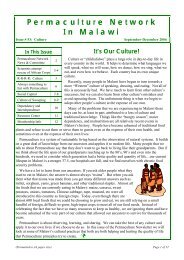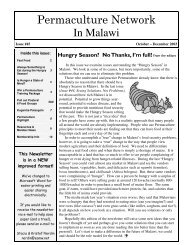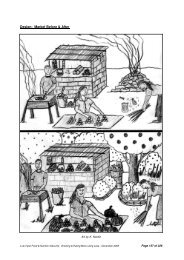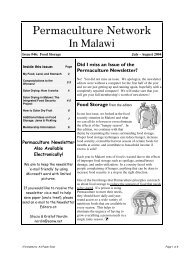Permaculture, Final Capstone Paper 5-26, Hope - Never Ending Food
Permaculture, Final Capstone Paper 5-26, Hope - Never Ending Food
Permaculture, Final Capstone Paper 5-26, Hope - Never Ending Food
Create successful ePaper yourself
Turn your PDF publications into a flip-book with our unique Google optimized e-Paper software.
2. Rare examples can be costly to identify in terms of both time and money. Common<br />
examples do not stimulate new thinking<br />
3. It is an inappropriate approach in settings where positive deviant behavior is not<br />
possible; for example, when necessary resources are not available<br />
4. Traditionally small sample size has led to criticism about the validity of<br />
generalizations<br />
5. Scale-up requires human resources, community mobilization, and capacity building in<br />
the areas of participatory research and the concept of positive deviance.<br />
Similarly, Karen Lapping (2003) of Save the Children USA writes that “statistical significance<br />
and quantitative rigor is not the goal of positive deviance. Rather, it is a problem-solving tool<br />
that can be widely applied to social and behavioral information of practical relevance to inform<br />
programmatic realities” (p.13).<br />
Perhaps the most useful aspect of Positive Deviance is the basic underlying assumption<br />
that in every community and organization there are individuals whose deviant behavior results in<br />
viable innovations and solutions to local problems. In his study of Kenyan agriculture, Ochieng<br />
(2006) sees the potential of the PD framework in facilitating understanding both at the grassroots<br />
and at the policy level. Ochieng postulates “the resources needed for development (financial and<br />
intellectual) may already exist within African organizations and institutions” (p. 458). The<br />
ability to recognize and then harness such PD solutions represents a significant paradigmatic<br />
shift from contemporary development thought, but, argues Ochieng, such a shift has huge<br />
implications for development policy and practice in Africa (p. 458).<br />
2. Adoption of Agricultural Technologies and Practices<br />
There is an abundance of literature available on theories of agricultural innovation and<br />
technological change (Feder & Slade, 1984; Feder, Just, & Zilberman, 1984; Binswanger, 1986;<br />
Goldman, 1993; Chirwa, 2005; Simtowe, 2007) most of which relates to the adoption of “new”,<br />
“modern”, or (internationally) “conventional” methods of agriculture such as the introduction<br />
17








